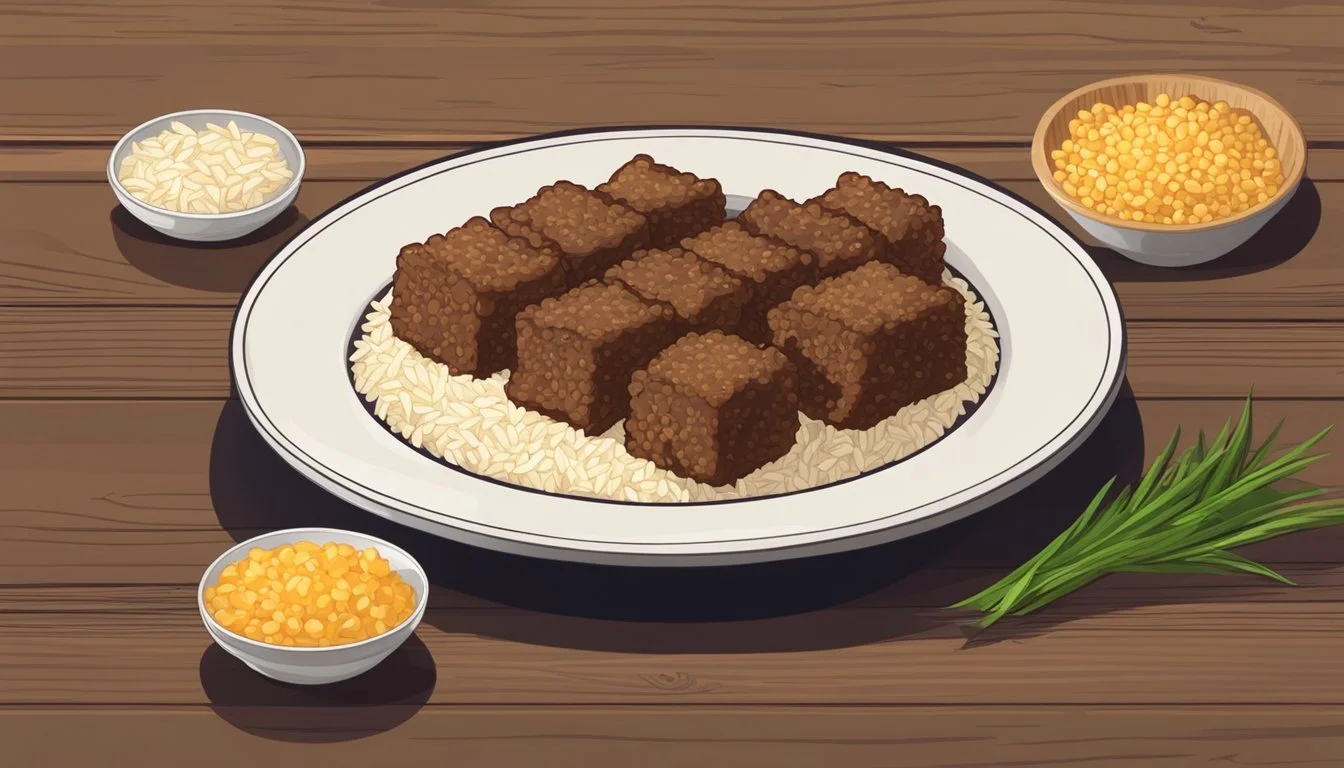How Long Do Beef and Rice Bites Last?
Storage Tips and Shelf Life
Beef and rice bites are a convenient and delicious meal option that can be stored for several days. Knowing how long these tasty bites can last is essential to ensure both flavor and safety. In the fridge, cooked beef bites can remain fresh for up to 3-4 days when properly stored in an airtight container, while rice lasts about the same amount of time.
Proper storage is key to maintaining the quality and safety of your beef and rice bites. Keeping them in the fridge quickly after cooking will help prevent unwanted bacteria growth. If you plan to store them longer, freezing is an effective option, extending their shelf life up to 2-3 months.
No one likes food waste, so it's crucial to be aware of storage times and conditions. Whether making a big batch for meal prep or saving leftovers from dinner, adhering to these guidelines will ensure your beef and rice bites stay delicious and safe to eat.
Understanding Beef and Rice Bites
Beef and rice bites are a popular dish combining succulent beef with hearty rice, typically in bite-sized portions. Key elements include the types of beef and rice used and their nutritional benefits.
Components and Types
Ingredients: The primary components are beef and rice. Beef can be used in various forms such as steak bites, beef tips, or marinated beef. Rice, often white or brown, is a staple that complements the meat.
Preparation: Recipes may involve searing the beef and cooking the rice separately or integrating them in one pot. For example, in a skillet, beef is often seared with garlic and butter, then mixed with cooked rice lightly seasoned.
Variations:
Garlic Butter Steak Bites with Rice: Beef sautéed with garlic and butter, served over rice.
Instant Pot Beef Tips and Rice: Using a pressure cooker for tender beef and flavorful rice.
Slow Cooker Beef Tips and Rice: Slow-cooked beef with rice, ideal for hands-off preparation.
Nutritional Value
Calories and Macros: Beef and rice bites are generally high in protein due to beef content. Depending on the cut used, they can vary in fat content. Rice adds carbohydrates, making it a balanced meal.
Protein: Beef is a significant source of protein. For instance, 100 grams of beef provides approximately 26 grams of protein.
Fats: Beef contains saturated and unsaturated fats. Lean cuts will have less saturated fat.
Carbohydrates: Rice contributes to the carbohydrate content. Brown rice adds fiber, which is beneficial for digestion.
Micronutrients: Nutrient content varies but typically includes:
Cholesterol: Beef contains cholesterol, with leaner cuts being lower.
Sodium: Can vary based on seasoning and preparation methods.
Additional Nutrients: Beef provides iron and B vitamins; rice offers vitamins like niacin and manganese.
Nutrient intake depends greatly on portion sizes and specific recipes used, so it's important to adjust based on dietary needs.
Preparation Techniques
Proper preparation ensures that beef and rice bites turn out flavorful and tender. Key methods include searing the meat, which locks in juices, and creating a flavorful base with ingredients like garlic, onions, and herbs.
Searing Meat
Searing the meat is crucial for developing rich, deep flavors. Start by heating a skillet over medium-high heat and adding a small amount of olive oil or butter. The oil should be hot enough to sizzle when the beef touches it. Cut the beef into bite-sized pieces and season with salt and pepper.
Place the beef in the skillet in a single layer to avoid overcrowding, which can steam the meat instead of searing it. Let each piece cook until a brown crust forms, usually 2-3 minutes per side, then remove and set aside. The browned bits left in the skillet, called fond, are packed with flavor and will enhance the cooking liquid.
Creating a Flavorful Base
Creating a flavorful base involves using ingredients like garlic, onions, and broth. After searing the meat, add chopped onion to the skillet and cook until they're tender, around 5 minutes. Use a mix of olive oil and butter for the best flavor. Add minced garlic and cook for about 1 minute, ensuring it doesn't burn.
Next, deglaze the skillet by adding beef broth or wine, scraping the browned bits from the bottom. This step infuses the liquid with the fond’s flavors. Add herbs such as rosemary or thyme for additional complexity. Simmer the mixture to allow the flavors to meld. This rich, aromatic base will significantly enhance the beef and rice bites.
Cooking and Storing
Beef and rice bites can be enjoyed fresh or stored for future use. Proper cooking techniques and storage conditions ensure they remain safe and delicious.
Optimal Cook Time
For perfectly cooked beef and rice bites, aim for a balanced cook time. Slow cooker beef tips or beef stew meat should be cooked low and slow to achieve tenderness.
Prep time typically includes seasoning and cutting the meat into bite-sized pieces. Use a food thermometer to check the internal temperature of the beef, ensuring it reaches 145°F (63°C) for safe consumption.
Cook the rice separately, and combine it with the beef during the final stages of cooking to avoid overcooking the rice.
Maximizing Freshness
Maximize the freshness of beef and rice bites by paying close attention to storage. Refrigerate cooked beef and rice within two hours to prevent bacterial growth and potential food poisoning.
Store leftovers in air-tight containers. Beef can be stored in the fridge at 40°F (4°C) for 3 to 4 days. Cooked rice, when stored properly, also lasts up to 4 days.
Label containers with the date to keep track of freshness.
Freezing and Thawing
Freezing extends the shelf life of beef and rice bites. Place them in freezer-safe, air-tight containers or vacuum-sealed bags.
For best quality, consume within two to three months. Thaw in the refrigerator overnight.
Avoid thawing at room temperature to reduce the risk of bacterial growth. Reheat thoroughly, ensuring the beef reaches an internal temperature of 165°F (74°C).
Proper freezing and thawing techniques make enjoying beef and rice bites convenient while maintaining safety and flavor.
Side Dishes and Variations
Choosing the right accompaniments and variations can elevate beef and rice bites, enhancing their flavors and textures.
Recommended Accompaniments
Mashed Potatoes: Creamy mashed potatoes pair excellently with beef and rice bites, offering a comforting contrast to the savory meat.
Green Beans: Steamed or sautéed green beans provide a fresh, crunchy balance. They add color and nutrients, making the meal more wholesome.
Broccoli: Like green beans, broccoli complements the richness of beef with its slightly bitter taste and crisp texture.
Salad: A light butter lettuce salad or a tabbouleh salad can bring a refreshing, zesty touch to the plate.
Gravy: Smothering the beef and rice bites in a rich gravy can make the meal more indulgent and flavorful.
Alternative Variations
Cheesy Polenta Rounds: These add a creamy texture and a subtle cheesy flavor, making them an interesting alternative to traditional sides.
Truffle Cacio e Pepe: This Italian pasta dish introduces sophisticated flavors of truffle and pecorino romano cheese, perfect for an upscale twist.
Baked Mushroom Rice: This variation adds earthy mushroom flavors, enhancing the beef's taste and bringing more complexity to the dish.
Scalloped Potatoes: Layers of thinly sliced potatoes in a creamy sauce can be a luxurious addition, complementing the beef's tenderness.
Sauteed Mushrooms: Adding sautéed mushrooms can increase the umami flavor, making the dish heartier and more satisfying.
Safety Considerations
Ensuring the safety of beef and rice bites involves proper handling, storage, and cooking practices. These precautions help avoid foodborne illnesses and extend the edibility of the food.
Preventing Foodborne Illness
Preventing foodborne illness starts with proper hygiene. Wash hands thoroughly before handling food. Use separate utensils and cutting boards for raw beef to avoid cross-contamination.
Store cooked beef and rice in airtight containers in the fridge at 40°F (4°C) or below. Label and date containers to keep track of storage time.
Cooked beef: good for 3-4 days
Cooked rice: lasts up to 4 days
Discard if there’s any unusual odor or texture. Reheat leftovers to at least 165°F (74°C) before eating.
Proper Cooking Temperatures
Cooking beef to the correct temperature is crucial. Use a food thermometer to ensure safety.
Ground beef: cook to 160°F (71°C)
Steaks/roasts: minimum internal temperature of 145°F (63°C) with a 3-minute rest time
Cook rice properly, bringing water to a rapid boil, then simmer covered until water is absorbed. Cool rice quickly and refrigerate, avoiding temperatures between 40°F (4°C) and 140°F (60°C), which favor bacterial growth.
Ensure reheated beef and rice reach a safe temperature of 165°F (74°C).
Adhering to these guidelines significantly reduces the risk of foodborne illnesses.
Serving Suggestions
To elevate the delicious and hearty beef and rice bites, consider enhancing their taste and presentation alongside complementary dinner pairings. This approach promises not only a visually appealing dish but also a complete, satisfying meal.
Enhancing Taste and Presentation
Add fresh parsley as a garnish for a pop of color and fresh, savory notes. This simple touch can make the dish more visually appealing.
Use a recipe card to note any tweaks or special additions for reference during busy weeknights.
Incorporate a mix of textures—such as a crisp side salad or steamed vegetables to contrast the tenderness of the beef bites.
Cook the beef in a rich beef broth to enhance depth of flavor. Worcestershire sauce can also be used to add a savory kick.
Dinner Pairings
Pair the beef and rice bites with a robust red wine like a Cabernet Sauvignon to complement the rich flavors of the dish.
Serve with a side of buttered green beans or roasted carrots to add both color and nutritional value to the meal.
For an extra touch of comfort food, garlic mashed potatoes can be served alongside. The buttery, creamy texture balances well with the hearty beef bites.
Salads with citrus vinaigrette can lighten the palate, making for a refreshing contrast. Hearty meals like this benefit from a balanced side to enhance the overall dining experience.
Recipe Tips and Tricks
When preparing beef and rice bites, enhancing texture and flavors is crucial for a satisfying dish. Effective techniques include using the right thickening agents and carefully balancing the seasoning.
Improving Texture and Consistency
A key step to achieving tender beef is simmering the meat slowly. Browning the beef first in a mix of butter and oil helps to lock in juices. Adding a cornstarch slurry can enhance the sauce's consistency. To make a slurry, mix 1 tablespoon of cornstarch with 2 tablespoons of cold water or broth. Gradually stir this into the pot and bring to a boil, then reduce the heat to medium. This prevents a cornstarchy taste and ensures a smooth sauce.
In some recipes, flour can be used as a thickening agent. Whisk together the flour with water until smooth, and add it to the simmering beef. This method will give the dish a more velvety texture. Adjust with broth if the mixture becomes too thick. For a unique touch, adding small amounts of soy sauce can improve the overall mouthfeel without making the dish too salty.
Enhancing Flavors
To maximize the flavor, combining ingredients like garlic, soy sauce, and Worcestershire sauce is essential. Start by adding garlic cloves while the beef cooks to infuse the dish with a robust aroma. Finely chopped garlic ensures even distribution and prevents burning.
Pepper and black pepper are fundamental spices that complement the beef's richness and enhance the dish's overall character. Careful seasoning balances without overpowering. Garlic butter steak bites can be an excellent addition for those wanting a richer flavor. To prepare this, melt butter and sauté garlic until fragrant, then toss the beef bites in this mix.
Incorporate fresh or dried herbs like thyme and rosemary to add depth. A splash of soy sauce brings umami, creating a richer, more complex taste profile. Don't forget to taste frequently and adjust salt levels accordingly to ensure a well-rounded flavor.
Additional Information
Beef and rice bites can be tailored to meet various dietary requirements and preferences. These adaptations make the dish suitable for a wider audience. Variations inspired by different cultures also bring new flavors and textures to the classic combination of beef and rice.
Adapting for Dietary Restrictions
People with gluten intolerance can enjoy beef and rice bites by ensuring all ingredients are gluten-free. Tamari sauce can be used instead of soy sauce, and gluten-free cornstarch acts as a thickener. For a sugar-free version, use natural sweeteners like stevia or monk fruit.
Incorporate options for a low-carb diet by using cauliflower rice. This significantly reduces the carb content while maintaining a similar texture. Additionally, include healthier fats and lean cuts of beef to adhere to dietary preferences centered around low-carb and keto guidelines.
Exploring Cultural Variations
Incorporating elements from global cuisine can transform traditional beef and rice bites. For an Asian twist, use ingredients like ginger, sesame oil, and soy sauce. Swap rice for jasmine or sticky rice to enhance authenticity.
Mediterranean variations can include olive oil, lemon juice, oregano, and feta cheese. Using wild rice or quinoa can offer a nutritious, hearty base. Fusion recipes like adding taco seasoning and salsa present a unique Mexican-inspired version, bringing a vibrant mix of flavors to the dish.








